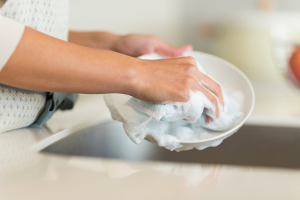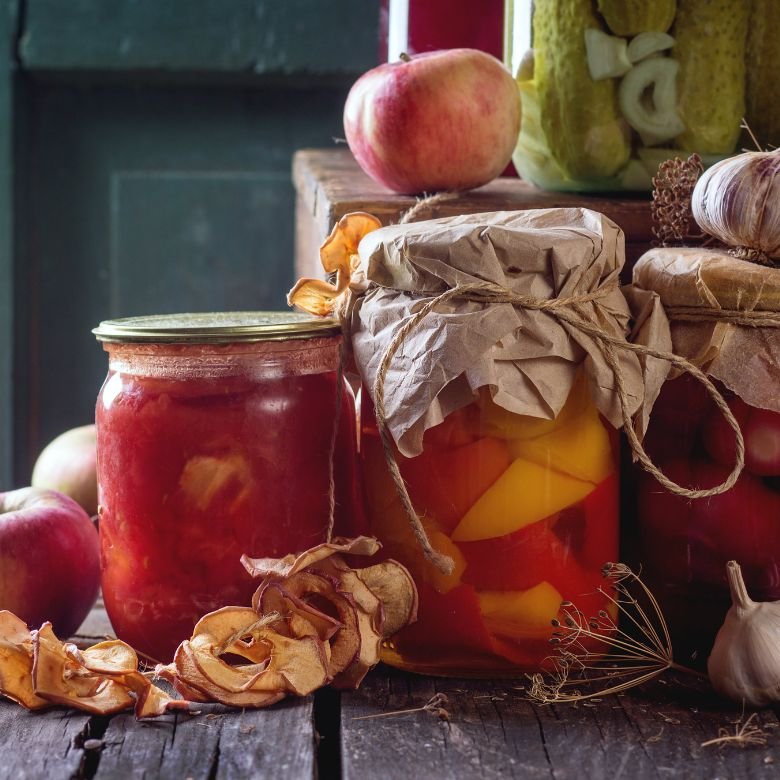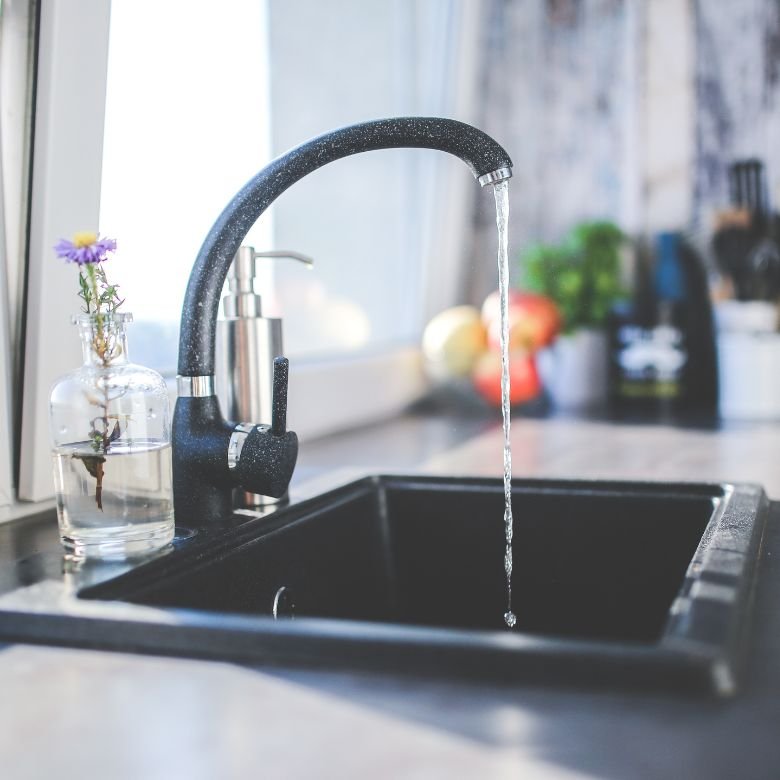Preparing meals is one of those everyday rituals that many of us just cannot imagine a day without. However, your kitchen is not only the place where your favourite dishes are prepared. It is also quite a nice laboratory where you deal with various elements, compounds and chemical substances. What do you need to know about them, how do they influence your health as well as the taste and quality of the food you prepare? Read on to learn.

Chemistry in your kitchen: where exactly do you find it?
Dishwashing liquids, cleaning agents and disinfectants as along with food products are only a few of the things that contain within them a variety of chemical compounds. However, before we get into their detailed composition, let’s first say a few words about the most basic products. You surely cannot imagine cooking without such staples as table salt (sodium chloride, NaCl), vinegar (an aqueous solution of acetic acid, CH3COOH) or sodium bicarbonate, commonly known as baking soda (NaCHO3). The latter ingredient is often added to baking powders that can also be based on ammonium bicarbonate (NH4HCO3). Most homes also have a stock of sucrose (C12H22O11), commonly known as sugar, a substance made up of D-fructose and D-glucose residuals, which is classified as a disaccharide.
Varying concentrations of elements and compounds are also contained in tap water. And if you have a refrigerator of an older generation, it almost certainly contains Freon or another gas. Newer appliances have refrigerants made from less harmful substances.
Yet, we should now take a closer look at another group of chemicals that we encounter daily when doing things in the kitchen.
Dishwashing liquids and their composition
Washing dishes is one of the activities that cannot be done without chemicals. The exact chemical composition of the liquids may vary between manufacturers and brands, but virtually all of them contain the following substances:
- Detergents – these are active compounds that dissolve and remove grime and grease. Examples of detergents include products available from PCC Group such as ROKAnol® L4 and C12-15 propoxylated fatty alcohol.
- Foaming agents – promote generation of thick foam, examples of finished products include Rosulfan A70 and SULFOROKAnol L270/1.
- Preservatives – these are compounds whose main aim is to prevent growth of bacteria and fungi in the product, examples of which include benzoic acid and potassium sorbate.
- Water softeners – they soften hard water and help detergents work more efficiently.
- Fragrances – they are added to cleaning products to give them a pleasant aroma.
Some dishwashing liquids also contain ingredients that make them more efficient in removing tough stains such as grease and deposits. These include enzymes and organic solvents. The latter include certain hydrocarbons and alcohols, among others.
What chemical compounds are found in disinfectants?
In recent years, much attention has been paid to effective disinfection of various surfaces, from kitchen countertops through furniture to dishes and utensils. Viruses and bacteria can be eliminated if disinfectants include such ingredients as:
- Chlorhexidine – a biguanide derivative, it is effective against many bacteria and viruses.
- Ethyl alcohol (ethanol) – its sufficiently high concentrations have strong antiviral and antibacterial effects.
- Ammonia – it eliminates fungi and removes soap and grease deposits.
- Perhydrol – a strong disinfectant, it is composed of a solution of hydrogen peroxide in water, contained among others in products for disinfecting wood, walls or textiles.
- Sodium hydroxide, or caustic soda –a low-toxicity and versatile agent, it is an essential ingredient in the production of sodium soap (a product found in PCC Group’s portfolio).
See the range of disinfectants from the PCC Group.

Preservatives – ingredients in many food products
Another group of chemical compounds that can be found in your kitchen are food additives. They are designed to extend the shelf life of food and prevent the growth of bacteria, fungi and other microorganisms that can cause oxidation and spoil the product.
Preservatives are classified into a number of major groups, including:
- antibacterial preservatives – prevent bacterial growth,
- antifungal preservatives – inhibit fungal growth,
- antioxidant preservatives – protect the food product from oxidation and loss of colour.
Which preservatives are found in food?
Most of us have heard about the mysterious “E” substances added to various foods. Manufacturers use different types of preservatives, the most popular being:
- sorbic acid (E200) – used as a moisture retaining agent in yoghurts, juices and other dairy products, and also in frozen foods and confectionery,
- benzoic acid (E210) – inhibits the growth of mould and fungi, used in tinned products and sauces, among other things,
- ethyl para-hydroxybenzoate (E214) – used in meat and fish products to extend their shelf life,
- sodium methylparaben (E219) – a product that extends shelf life and inhibits the growth of certain bacteria and fungi,
- methylparaben (E218) – used in cosmetic products and foods such as juices, jams, marmalades, cakes and pickles,
- potassium sorbate (E202) – a fungicide, considered the safest of all the preservatives added to food products. It is found in cheese, sweets, juices and fruit drinks.
Which elements and chemical compounds are found in tap water?
When you pour yourself a glass of water from the tap, you can also come across a number of chemical compounds present in the tap water, the composition of which depends on water quality and treatment methods. Which elements and substances (besides oxygen and hydrogen, obviously) are most commonly found in tap water?
- Chlorine – added as a disinfectant, which neutralises bacteria and other microorganisms.
- Iron and manganese – they are often found in tap water as natural contaminants.
- Ammonia – it may be present in tap water as a result of industrial pollution or from malfunctioning wastewater treatment plants.
- Fluoride – added to water in some regions for preventive dental health.
- Calcium and magnesium salts (such as calcium carbonate) – these are minerals that occur naturally in water.
Tap water is subject to regular testing. Local authorities that manage water supply systems are required to monitor water quality and adjust treatment processes to make water meet the mandatory standards and quality requirements.

Chemicals found in refrigeration appliances
Chemistry in the kitchen involves not only food and detergents, but also electrical appliances. Thermal insulation of refrigerators can contain formaldehyde, which is considered harmful to health. Older refrigerators and air conditioners are also a source of hydrofluorocarbons (HFCs), which are greenhouse gases harmful for the climate.
Many countries, including the European Union, have introduced regulations banning the use of such substances in new household appliances. As a result, refrigerator and freezer manufacturers have begun to use other refrigerants that are considered more environmentally friendly, such as propane (R290) or isobutane (R-600A).
Chemistry in the kitchen – make informed choices!
The elements and compounds we have just covered are only the most common and well-known examples of chemicals in your kitchen. Many of them are essential to ensure product quality. However, it is worth to remember that some preservatives added to food or active substances used in cleaning fluids can have a negative impact on both your health and the environment. What can be done to minimise the risk?
Although you probably cannot control the presence of metals in tap water, you can reduce their harmful effects by choosing the right filters. When doing your everyday grocery shopping, make sure to carefully read the composition of products to find out if their manufacturers use preservatives and which ones are in the product. When choosing household appliances, you should check that no harmful materials or greenhouse gases are used for their production. Green chemistry, i.e., cleaning and care products based on organic ingredients, is also gaining a momentum among consumers. These are only some examples of things you can do right away to minimise the impact of the most harmful chemicals on your daily life.